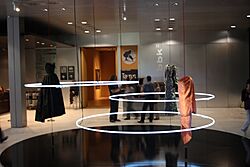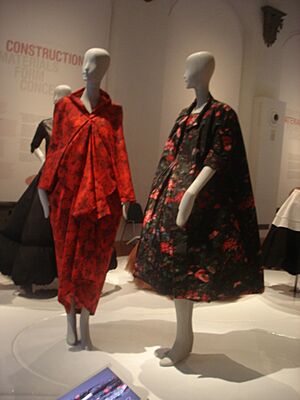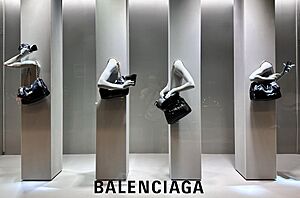Balenciaga facts for kids
| Subsidiary (société anonyme) | |
| Industry | Fashion |
| Predecessor |
|
| Founded | San Sebastián, Spain, 1919 |
| Founder | Cristóbal Balenciaga |
| Headquarters | |
|
Area served
|
Worldwide |
|
Key people
|
|
|
Number of employees
|
1,325 (2019) |
| Parent | Kering |
Balenciaga (/bəˌlɛnsiˈɑːɡə/ bə-LEN-see-AH-gə) is a French luxury fashion line that was founded in 1919 by Spanish couturier Cristóbal Balenciaga in San Sebastián. Balenciaga produces ready-to-wear footwear, handbags, and accessories, and licenses its name and branding to Coty for fragrances. It is currently owned by the French corporation Kering.
Contents
History
Founding to 1980
Cristóbal Balenciaga opened his first boutique in San Sebastián, Spain, in 1919, and expanded to include branches in Madrid and Barcelona. The Spanish royal family and aristocracy wore his designs. When the Spanish Civil War forced him to close his stores, he moved to Paris.
Balenciaga opened his Paris couture house on Avenue George V in August 1937, where his first fashion show featured designs heavily influenced by the Spanish Renaissance. His success was nearly immediate. In two years, the press lauded him as a revolutionary, and his designs were highly sought-after. Carmel Snow, the editor of Harper's Bazaar, was an early champion of his designs.
Customers risked their safety traveling to Europe during World War II to see Balenciaga's clothing. During this period, he was noted for his "square coat", with sleeves cut in a single piece with the yoke, and for his designs with black (or black and brown) lace over bright pink fabric. Historians believe that Balenciaga's continued activity during the Nazi occupation of Paris was made possible by his connections with Spanish dictator General Francisco Franco who was Adolf Hitler's close ally. The relation to Franco was so close that Balenciaga designed clothing for the Franco family. The company was one of only 60 allowed to operate during the occupation, and the ongoing supply of raw materials from Spain, which were in short supply in Paris due to the war, gave Balenciaga a competitive advantage. However, he testified that he refused Hitler's request to transfer his company's activities to Berlin.
During the post-war years, his lines became more linear and sleek, diverging from the hourglass shape popularized by "Christian Dior's New Look". The fluidity of his silhouettes enabled him to manipulate the relationship between his clothing and women's bodies. In 1951, he transformed the silhouette, broadening the shoulders and removing the waist. In 1955, he designed the tunic dress, which later developed into the chemise dress of 1958. Other contributions in the postwar era included the spherical balloon jacket (1953), the high-waisted baby doll dress (1957), the cocoon coat (1957), the balloon skirt (1957), and the sack dress (1957). In 1959, his work culminated in the Empire line, with high-waisted dresses and coats cut like kimono. His manipulation of the waist, in particular, constituted "what is considered to be his most important contribution to the world of fashion: a new silhouette for women".
In the 1960s, Balenciaga tended toward heavy fabrics, intricate embroidery, and bold materials. His trademarks included "collars that stood away from the collarbone to give a swanlike appearance" and shortened "bracelet" sleeves. His often spare, sculptural creations—including funnel-shape gowns of stiff duchess satin worn to acclaim by clients such as Pauline de Rothschild, Bunny Mellon, Marella Agnelli, Hope Portocarrero, Gloria Guinness, and Mona von Bismarck—were considered masterworks of haute couture in the 1950s and 1960s. In 1960, he designed the wedding dress for Queen Fabiola of Belgium made of ivory duchess satin trimmed with white mink at the collar and the hips. Jackie Kennedy famously upset her husband by buying Balenciaga's expensive creations while John F. Kennedy was president – he apparently feared that the American public might think the purchases too lavish. Her haute couture bills were eventually discreetly paid by her father-in-law, Joseph Kennedy.
Protégés
Several designers who worked for Balenciaga would go on to open their own successful couture houses, notably Oscar de la Renta (1949), Andre Courreges (1950), Emanuel Ungaro (1958), but his most famous and noted protégé was Hubert de Givenchy, who was the lone designer to side with Balenciaga against the Chambre Syndicale de la Haute Couture Parisienne and also the press over the scheduling of his shows.
Battle against the press
In 1957, Balenciaga famously decided to show his collection to the fashion press the day before the clothing retail delivery date, not the standard four weeks before the retail delivery date the fashion industry followed at the time. By keeping the press unaware of the design of his garments until the day before they were shipped to stores, he hoped to curtail ongoing piracy and copying of his designs. The press resisted, finding it nearly impossible to get his work into their print deadlines, but Balenciaga and protégé Givenchy stood firm, seriously impacting their coverage and press of the era. His supporters would argue that rival Christian Dior would gain acclaim from copying Balenciaga's silhouettes and cuts, claiming them as his own original work; because Balenciaga was not interested in press coverage, the media, and consumers never knew.
In 1967, both designers reversed their decision and joined the traditional schedule.
Battle against the Chambre
Balenciaga defiantly resisted the rules, guidelines, and bourgeoisie status of the Chambre syndicale de la haute couture parisienne, and, thus, was never a member.
Cristóbal Balenciaga closed his fashion house in 1968 and died in 1972. The house lay dormant until 1986.
1981 to 2010

Balenciaga is now owned by Kering and its womenswear and menswear was headed by Nicolas Ghesquière.
In 2002, Balenciaga's star, Nicolas Ghesquière, imitated the work of Kaisik Wong, a designer from San Francisco. Ghesquiere created a patchwork vest in his spring collection that resembled one that Wong designed in 1973. Ghesquière admitted in an interview in Paris that he had copied the garment.
Ghesquière's F/W 2005 line showed that the house was not only making money, but also attracted a number of celebrity customers including editor-in-chief at Vogue, Anna Wintour.
The House of Balenciaga designed the dresses worn by Jennifer Connelly and Nicole Kidman to the 2006 Academy Awards, as well as the wedding gown Kidman wore when she married Keith Urban. Kylie Minogue also wore a Balenciaga dress for her "Slow" and "Red Blooded Woman" music videos and for her concert tour.
Balenciaga's Fall/Winter 2007 show impressed Teen Vogue editor-in-chief Amy Astley so much that an entire spread in the magazine, titled "Global Studies" and shot in Beijing, was influenced by it. The line included skinny jodhpurs, tight, fitted blazers, beaded embellished scarves, and other multicultural mixes.
Balenciaga is known for creating avant-garde, advanced structural pieces, straddling the edge of fashion and forecasting the future of women's ready-to-wear fashion. Vintage Balenciaga garments are popular among fashion editors, Hollywood stars, and models, and have been seen on Sienna Miller, Lara Bingle, Raquel Zimmerman, Caroline Trentini, Emmanuelle Alt, Tatiana Sorokko, Hilary Rhoda, Jennifer Garner, and Stephanie Seymour, among others. Balenciaga is also frequently worn by actress Chloë Sevigny, who is also a muse of Nicolas Ghesquière.
2010 to present
In March 2011 at M. H. de Young Museum in San Francisco, USA, Balenciaga celebrated the opening of Balenciaga and Spain, a 120-piece fashion retrospective of Cristóbal Balenciaga's career. The exhibition included many designs from the museum's encyclopedic costume collection. "You can't even measure it", said Rodarte designer Laura Mulleavy of Cristóbal Balenciaga's influence. The $2,500-a-ticket fund-raiser for the museum drew 350 guests, including Denise Hale, Marissa Mayer, Vanessa Getty, Victoria Traina, Vanessa Traina, Jamie Tisch, Gwyneth Paltrow, Orlando Bloom, Balthazar Getty, Maggie Rizer, Connie Nielsen, Maria Bello, and Mia Wasikowska.
In June 2011, the Cristóbal Balenciaga Museum opened in Getaria, Spain.
In November 2012, Balenciaga announced that it was parting with creative director Nicolas Ghesquière, ending his 15-year tenure. The brand announced Alexander Wang as its new creative director. Wang presented his first collection for the label on 28 February 2013, at Paris Fashion Week. In 2014, the Tribunal de grande instance de Paris set a trial date for the lawsuit between Balenciaga vs. Ghesquière. Balenciaga claimed that Ghesquière's comments in the magazine System had hurt the company's image. The highly publicized suit was mediated out of court.
In July 2015, Balenciaga announced it was parting with creative director Alexander Wang after three years. The Spring/Summer 2016 show was his last, featuring white lounge wear made from soft, natural fabrics. In early October 2015, the brand appointed Demna Gvasalia as its new creative director.
In 2018, Balenciaga was the subject of a social media backlash in China when personnel at one of Balenciaga's Paris stores assaulted a Chinese tourist.
In, April 2021 Gvasalia presented his new Pre-Fall 2021 collection, as promoted by Vanity Teen magazine. In August 2021, Justin Bieber was announced as the new face of Balenciaga. In September 2021, the brand faced backlash when it released trompe-l'œil sweatpants with the illusion of plaid boxers sticking out the top with a price tag of $1,190. In May 2022, Balenciaga announced that it accepts crypto payments.
In October 2022 Balenciaga announced that it was severing its ties to Kanye West due to his anti-semitic comments.
In December 2023, Balenciaga was awarded by the People for the Ethical Treatment of Animals (PETA) with the prize for best luxury product for its entirely vegan coat made from Lunaform, a plant-based leather.
In May 2024, Balenciaga reinforces its presence in Japan with the opening of a new flagship store in Tokyo. Later in June, Balenciaga opened its first store in Cancún, Mexico.
Brand Ambassadors
In July 2023, Balenciaga announced its first-ever brand ambassadors, Isabelle Huppert and PP Krit Amnuaydechkorn. This is the first time in history, Balenciaga has announced a brand ambassador
In November 2023, Balenciaga appointed Michelle Yeoh as its brand ambassador.
In December 2023, Balenciaga introduced its new brand ambassador, Nicole Kidman.
In January 2024, Kim Kardashian became the brand ambassador of Balenciaga.
Support for Ukraine
In March 2022 during Paris Fashion Week, Balenciaga expressed support for Ukraine during the Russo-Ukrainian War. T-shirts in yellow and blue (like the Ukrainian flag) were placed on the chairs. Creative director Demna Gvasalia recited a poem "Live Ukraine, live for beauty" by Ukrainian writer Oleksandr Oles at the beginning and end of the show. He noted that this show is self-explanatory, as a dedication to "fearlessness, resistance, and the victory of love and peace". The brand also made donations to the UN World Food Programme to support Ukrainian refugees.
Creative directors
- Cristóbal Balenciaga – 1919 to 1968
- Michel Goma – 1987 to 1992
- Josephus Thimister – 1992 to 1997
- Nicolas Ghesquière – 1997 to 2012
- Alexander Wang – 2013 to 2015
- Demna Gvasalia – 2015 to present



